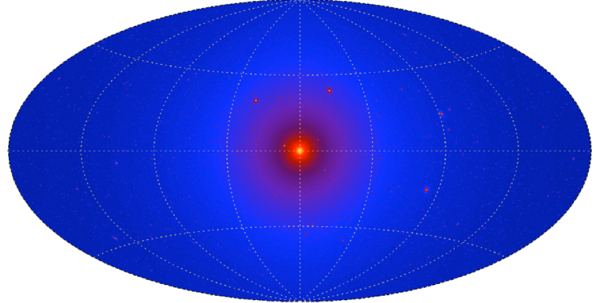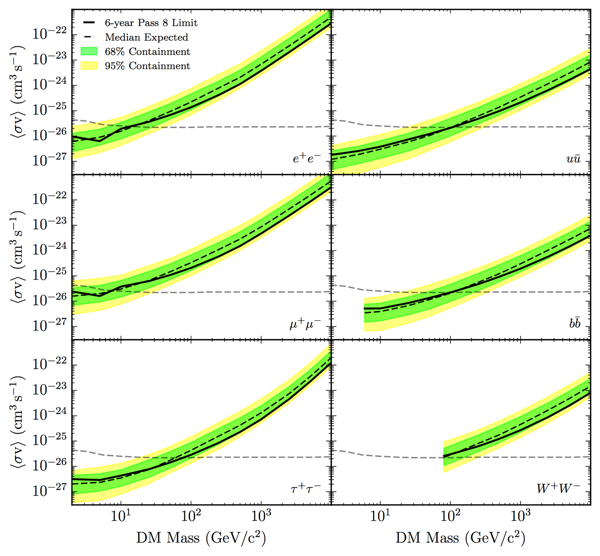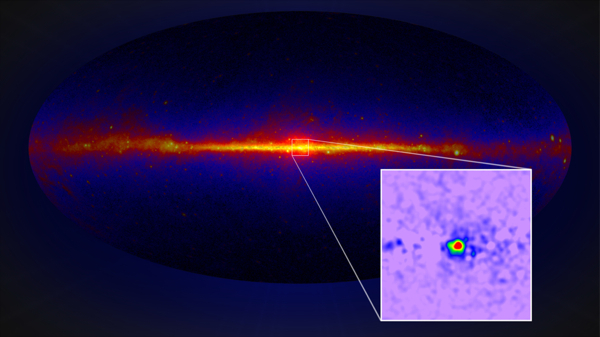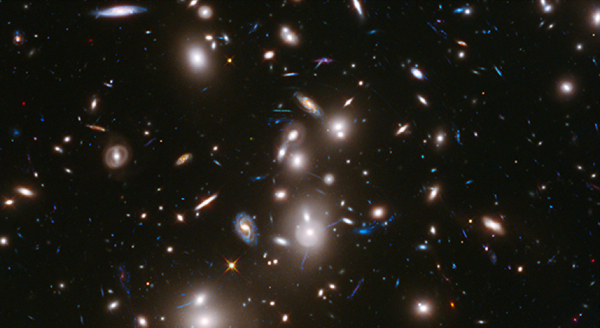Fermi Searches for Dark Matter
Cosmological observations indicate that a large amount of invisible, non-baryonic matter (dark matter) may comprise most of the matter in the Universe. However, its fundamental properties remain a mystery searches using particle accelerators have failed to detect this weakly-interacting material. As such, the nature of dark matter remains one of the most important puzzles in modern science.

Why Fermi-LAT?
The Fermi Large Area Telescope (LAT) observes the whole gamma-ray sky from 0.3-300 GeV. Though designed to detect gamma rays, the LAT can also detect cosmic-ray electrons and positrons (CREs). Some dark matter candidates such as weakly interacting massive particles (WIMPs), are thought to have self-annihilation cross sections and/or decay rates that would allow them to produce detectable particles, including gamma rays and CREs in the sensitivity range of Fermi-LAT. With its excellent sky coverage and sensitivity, Fermi-LAT provides a unique platform for indirect dark matter searches by surveying a wide variety of astrophysical sources and probing astrophysical processes that could reveal clues to the nature of dark matter. + Learn More

Dwarf Spheroidal Galaxy Searches
Dwarf spheroidal galaxies (dSphs) are considered to be excellent targets for indirect dark matter searches as they are believed to be dominated by dark matter and not contain a significant population of known gamma-ray sources. A study combining observations taken on 25 dSphs has provided some of the most constraining upper limits on the thermally averaged self-annihilation cross section of WIMP dark matter. + Learn More

An Excess At The Galactic Center?
The Galactic Center is predicted to be the closest, brightest source of gamma rays from dark matter annihilation. Analysis of the halo of the Galactic Center with Fermi-LAT (subtracting the diffuse emission from the region) by gamma-ray researchers has revealed a GeV excess near the Galactic Center. This excess has an energy spectrum that peaks at several GeV and is approximately spherically symmetric. Both of these features are consistent with expectations from a dark matter signal from the Galactic Center. While tantalizing, it is possible that this signal is instead due to conventional astrophysics (such as a population of millisecond pulsars) or an incomplete understanding of the subtracted background in the region. Additionally, a GeV excess at the Galactic Center with the observed properties is in tension with non-detections made of other dark matter targets (such as dwarf spheroidal galaxies). Future observations of both the Galactic Center region, as well as of dSphs, may provide additional information about the source of this excess.

Additional Dark Matter Targets
The hunt for dark matter continues with Fermi-LAT across a wide variety of astrophysical sources. Here are some additional targets used by Fermi-LAT scientists to search for the elusive gamma-ray signal indicative of the presence of particle dark matter.
Galaxy Clusters
Known to be the largest gravitationally bound structures in the universe, galaxy clusters are dominated by dark matter making them excellent targets for searches with Fermi-LAT. Current searches for gamma rays from nearby clusters have yet to reveal a significant gamma-ray signal. + Learn More

Gamma-ray Background
Dark matter annihilation, both locally and integrated over the history of the universe should produce a deviation in the expected diffuse gamma-ray background in Fermi-LAT observations. Careful examination of the spectral characteristics of the gamma-ray background within Fermi-LAT has already produced constraining limits on dark matter annihilation and will continue to do so over the lifetime of the mission. + Learn More



